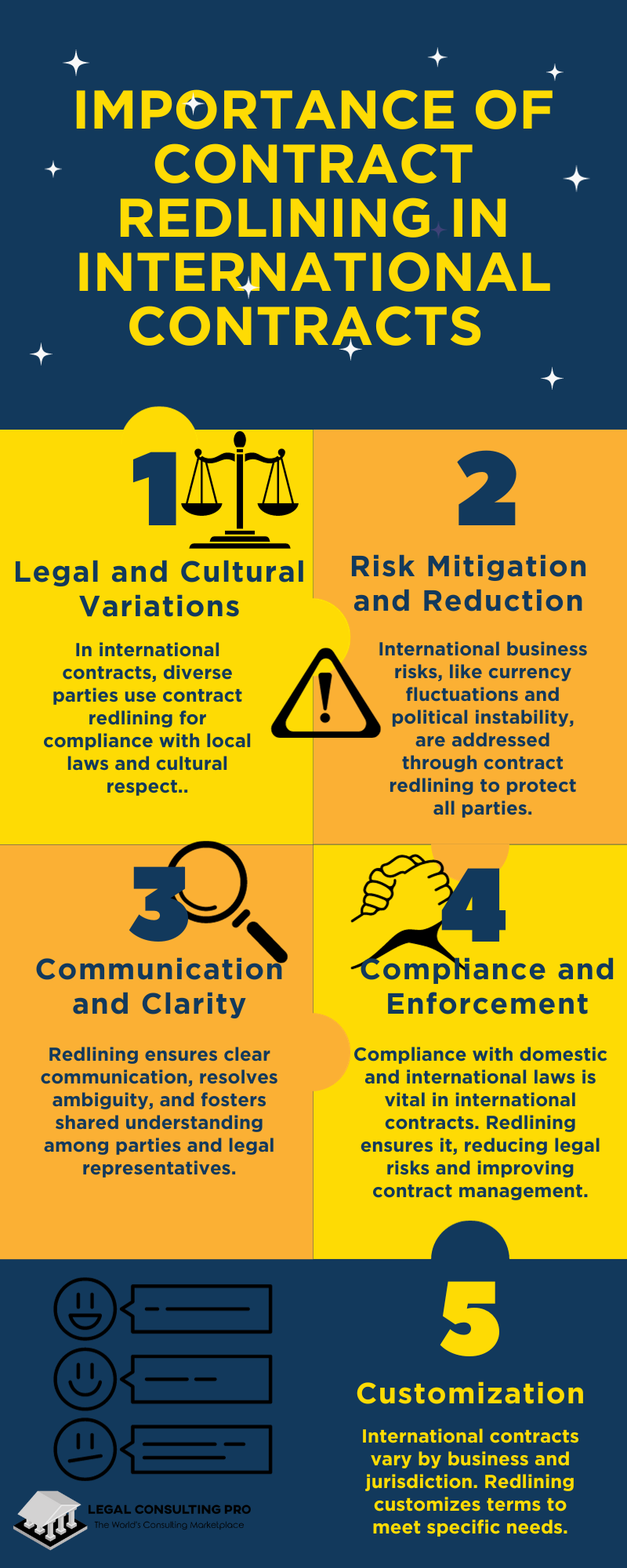Introduction
In the world of international business, the process of drafting, reviewing, and finalizing contracts is a critical aspect of the contract management process. It involves a meticulous examination of terms and conditions, to protect the interests of all parties involved. One essential aspect of this process is contract redlining, a practice that can greatly impact the outcome of cross-border agreements. In this article, we will delve into the nuances of contract redlining, focusing on its significance in international contracts and the legal implications that come with it.
Understanding Contract Redlining
Contract redlining, often referred to as “redline editing” or simply “redlining,” is the process of tracking and highlighting changes made to a contract document during its negotiation and review stages. These changes typically involve additions, deletions, or modifications to specific clauses, terms, or conditions within the contract. The term “redlining” derives from the traditional practice of using a red pen to mark these alterations on a physical document.
The primary purpose of redlining is to facilitate communication and transparency among parties involved in contract negotiations. It helps to ensure that all parties are aware of and can agree upon the proposed changes, preventing misunderstandings and disputes later on. Redlining plays a crucial role in streamlining the contract management process, making it more efficient and less error-prone.
To gain in-depth knowledge of Contract redlining, read: Cracking the Code: All You Need to Know About Contract Redlining
Importance of Contract Redlining in International Contracts
In the context of international contracts and contract management, contract redlining takes on added significance due to the complex nature of cross-border business agreements. Here are some key reasons why contract redlining is particularly crucial in the realm of international business:
Legal and Cultural Variations
International contracts often involve parties from different countries with distinct legal systems, languages, and cultural norms. Contract redlining allows for the careful examination of these variations, ensuring that the contract complies with local laws and respects cultural sensitivities.
Risk Mitigation
International business transactions carry inherent risks, such as currency fluctuations, political instability, and regulatory changes. Contract redlining helps identify and address potential risks by clarifying and modifying contractual terms to protect all parties involved.
Communication and Clarity
Redlining promotes effective communication between parties and their legal representatives. It helps to clarify intentions, resolve ambiguities, and ensure that all parties have a shared understanding of the contract’s terms and obligations.
Compliance and Enforcement
Ensuring that an international contract complies with both domestic and international laws is critical. Contract management and redlining allow for a comprehensive review to identify any provisions that may conflict with legal requirements, thus minimizing the risk of legal disputes and contributing towards simpler and more effective contract management.
Customization
Different international contracts have unique requirements, depending on the nature of the business and the jurisdictions involved. Redlining permits the customization of contract terms to suit the specific needs and expectations of the parties.

Contract Redlining for International Contracts Infographics
Contract Redlining Process
The contract redlining process involves several key steps that help streamline contract negotiations and foster an environment of collaboration. Let’s explore these steps:
- Initial Draft: The process begins with the creation of an initial draft of the contract. This draft serves as the starting point for negotiations and is typically prepared by one party or their legal counsel.
- Review and Edits: The parties involved, along with their legal teams, review the contract to identify areas that require modification. Edits can range from minor language tweaks to substantial revisions of contract clauses.
- Tracking Changes: As edits are made, changes are tracked using specialized software or tools designed for contract redlining. This ensures that every modification is transparent and easily traceable.
- Comments and Annotations: Parties may add comments and annotations to explain the rationale behind specific edits or to request further clarification on certain provisions. This helps in maintaining clear communication throughout the process.
- Negotiation and Iteration: The contract may go through several rounds of negotiation and revision, with parties proposing changes and counterchanges until a mutually acceptable agreement is reached.
- Final Approval: Once all parties are satisfied with the contract’s terms, a final version is created, incorporating all agreed-upon changes. This version is then ready for execution.
Legal Implications of Contract Redlining
Contract redlining can have several legal implications, particularly in international contracts, where the stakes are often higher. It is essential for parties to consider these implications to ensure the contract’s enforceability and compliance with relevant laws:
- Governing Law and Jurisdiction: Parties must specify the governing law and jurisdiction in international contracts. Contract redlining allows for the negotiation and agreement on these critical clauses, which can significantly impact dispute resolution.
- Language of the Contract: In cross-border contracts, determining the contract’s official language is vital. Redlining helps parties ensure that all versions of the contract are consistent and accurate in the chosen language.
- Force Majeure and Termination Clauses: Redlining helps parties clarify the circumstances under which the contract can be terminated or postponed, especially in situations beyond their control, such as force majeure events.
- Intellectual Property Rights: International contracts often involve the transfer of intellectual property rights. Redlining allows for detailed negotiations on IP-related clauses, including licensing, royalties, and ownership.
- Confidentiality and Non-Disclosure: Protecting sensitive information is paramount in international business. Contract redlining enables parties to define and strengthen confidentiality and non-disclosure clauses to safeguard their interests.
- Dispute Resolution Mechanisms: Redlining helps parties establish effective dispute resolution mechanisms, whether through arbitration, mediation, or litigation. Clear and mutually agreed-upon processes can save time and resources in the event of disputes.
- Compliance with Export Controls: In international trade, export control laws and regulations may apply. Parties must redline the contract to ensure compliance with export restrictions and licensing requirements.
- Currency and Payment Terms: Contract redlining allows for detailed negotiations on currency of payment, exchange rate mechanisms, and payment terms, which can be crucial in international transactions.
- Compliance with Local Laws: International contracts should comply with both international and local laws. Redlining ensures that all parties are aware of and agree to necessary modifications to align the contract with applicable regulations.
- Confidentiality of Redlined Versions: Parties must also consider the confidentiality of redlined versions of the contract, as they may contain sensitive negotiation information. Implementing robust confidentiality clauses can address this concern.
Conclusion
Redlining is a critical aspect of contract management, especially in the context of international agreements. It plays a pivotal role in facilitating effective communication, addressing legal implications, and mitigating risks associated with cross-border contracts. By carefully navigating the redlining process, parties can create well-crafted, legally compliant contracts that protect their interests and promote successful international business ventures. Whether it’s governing law, language, dispute resolution, or compliance with local regulations, contract redlining ensures that international contracts are well-prepared to meet the challenges of the global business landscape.







































